Regional Development Scenario Evaluation through Land Use Modelling and Opportunity Mapping
Abstract
:1. Introduction
2. Methodology
- Simulating regional development quantitative scenarios by using a cellular automata (CA) (a class of spatially-disaggregate models, often pictured as being formed on a 2-dimensional lattice of cells, where each cell represents a land use and where embodying processes of change in the cellular state are determined in the local neighbourhood of any and every cell [17])-based land use model, MOLAND;
- Elaborating indicators to identify and define the most suitable indicators for analysis;
- Creating indicator maps within a Geographical Information System (GIS) environment to support policy makers in assessing how those indicators change in the case of different future scenarios.
2.1. Study Area
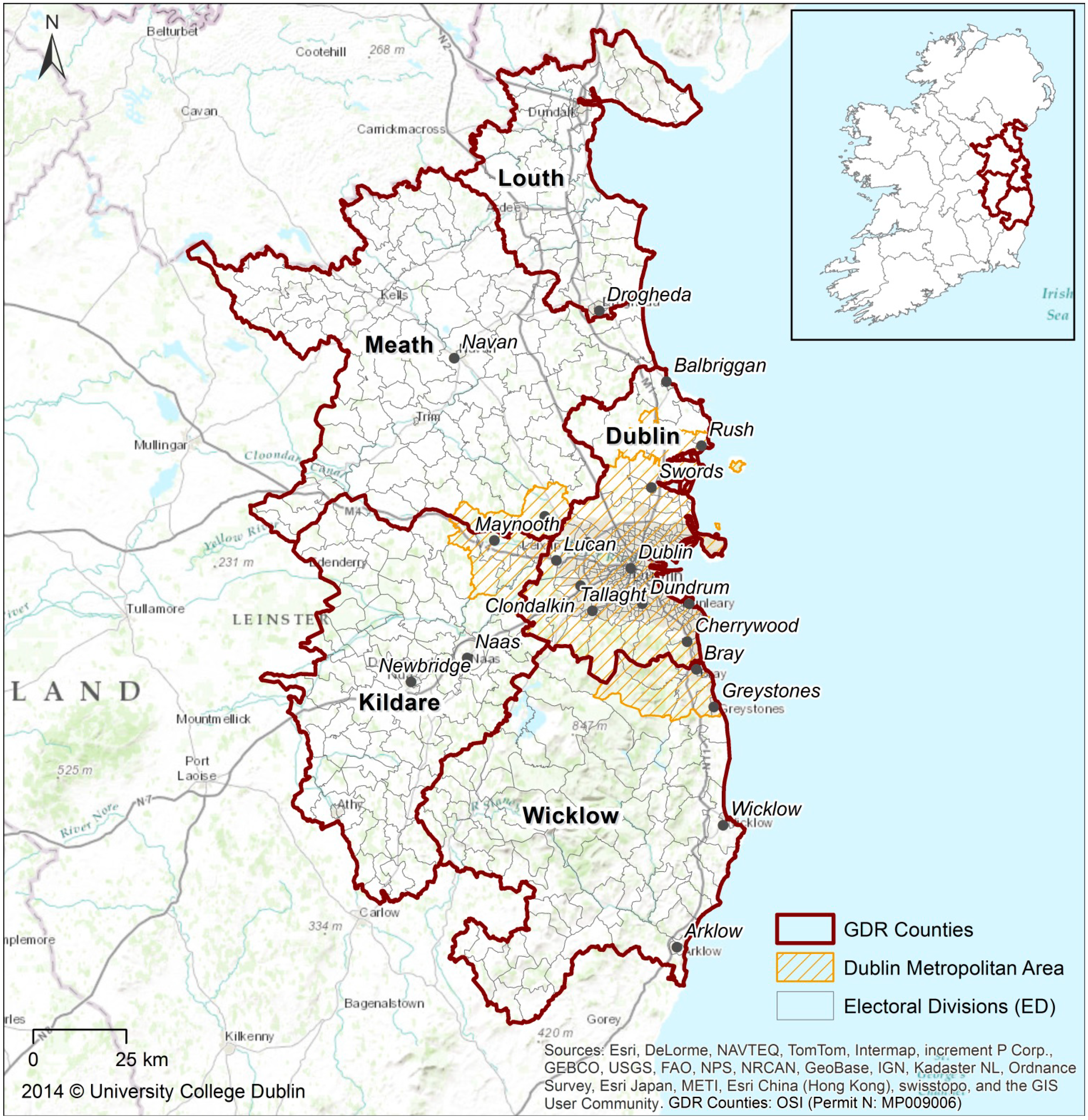
2.2. Land Use Model MOLAND
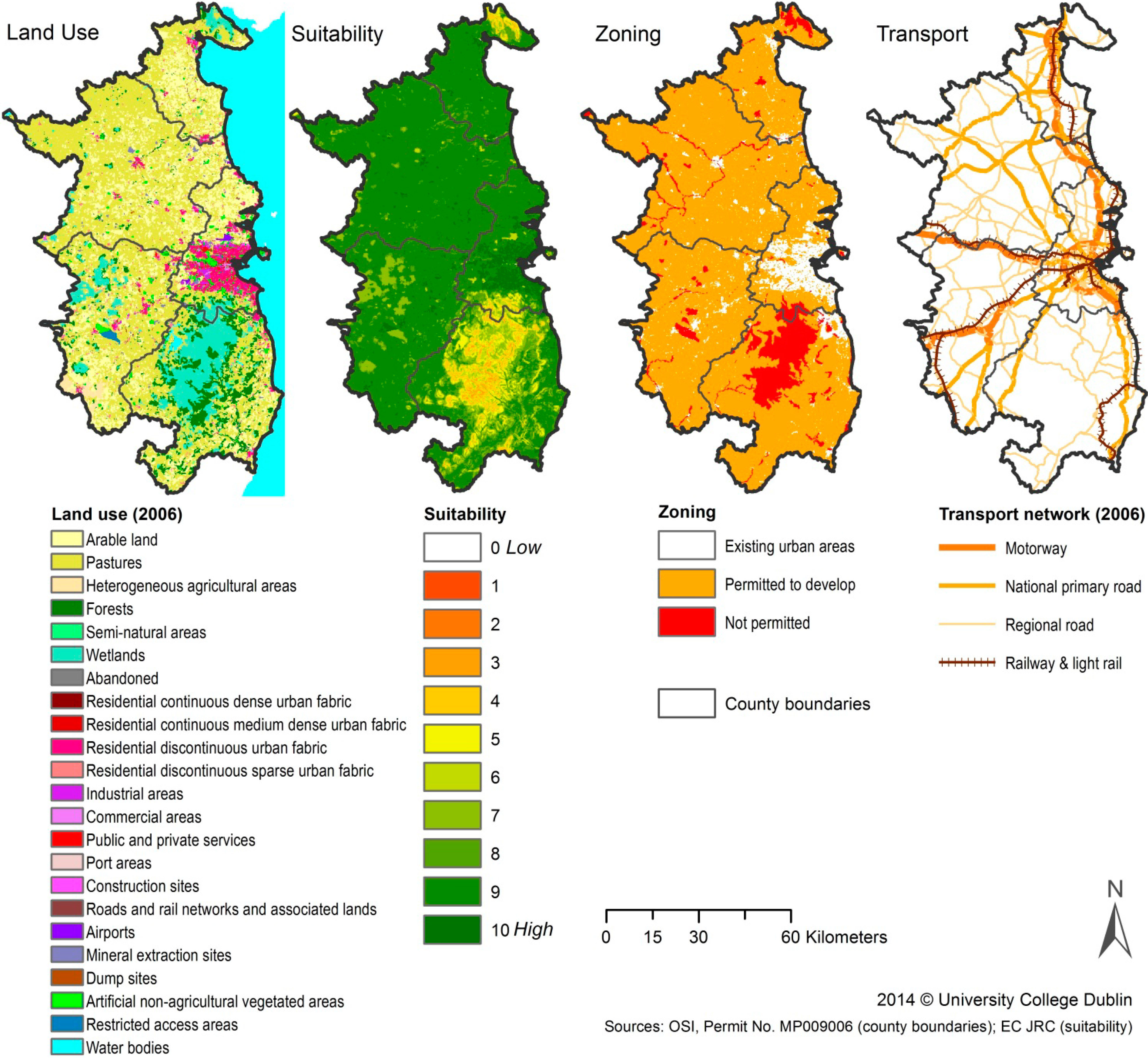
2.3. Scenarios
| Scenario | Suitability and Transport | Population 2026 | Jobs 2026 | ||
|---|---|---|---|---|---|
| Industry | Commerce | Service | |||
| Pre-recession trends or business as usual Further development of urban patterns as emerged before the economic crisis. | Default suitability (as in Figure 2); New light rail lines are introduced by 2020. | 2,553,149 | 380,573 | 559,519 | 362,129 |
| Compact Development Urban growth and regional development in the frame of a strong environmental protection policy with less pressure on natural land uses. | Specific suitability map promoting urban development in the metropolitan area and key towns with restricted zone along coastline. New light rail lines are introduced by 2020. | 2,553,149 | 544,219 | 800,112 | 517,844 |
| Managed Dispersed Growth and sprawl of rural town and villages in open countryside particularly along the Dublin-Belfast corridor. | Specific suitability map promoting urban development in metropolitan area, key towns, as well as along the Dublin-Belfast corridor. | 2,553,148 | 418,630 | 615,471 | 398,342 |
| Recession Slow urban development due to recession, including a potential recovery by 2016. | Default suitability (as in Figure 2). | 2,133,819 | 300,603 | 372,329 | 244,898 |
2.4. Informing Decision Makers
- (a)
- The model is trying to gauge the land use change caused by specific policies. In this case, the transport network, zoning and suitability maps are key elements of the MOLAND, allowing it to reproduce characteristics of a scenario [10]. Both zoning and suitability maps represent the capacity of a cell to support a particular land use. Transport network updates, such as new light rail lines, might shift the use of land in the future. The customization of these elements together with the fine tuning of other parameters (such as population and job projections) can permit decision makers to explore specific scenarios.
- (b)
- The model can also help policy makers by using a reverse direction argument. This argument assumes certain inputs are out of the control of policy makers (such as population and migration), but those population dynamics will cause land use change in the future. Thus, the model can inform policy makers about which locations will change the most in case of specific population and employment projections and, hence, locations that will demand policies to address higher population density, investment in infrastructure, etc. [22].
2.5. Indicators
| N | Indicator (Variable Name) | Description | Effect (Direction Preference) |
|---|---|---|---|
| 1 | Proximity to urban green areas (Dist_Res2Grn) | Mean minimum distance from residential areas in an ED to semi-natural (beaches, sand plains, natural grassland, woodland shrub, etc.), forest and artificially vegetated areas (parks, sport facilities, etc.). | Negative |
| 2 | Distance to industrial areas (Dist_Res2Ind) | Mean minimum distance from residential areas in an ED to industrial areas. | Positive |
| 3 | Proximity to commercial areas (Dist_Res2Com) | Mean minimum distance from residential areas in an ED to commercial areas. | Negative |
| 4 | Proximity to services (Dist_Res2Ser) | Mean minimum distance from residential areas in an ED to service areas. | Negative |
| 5 | Proximity to main roads (Dist_Res2Rd) | Mean minimum distance from residential areas in an ED to main roads (motorway, national and regional roads). | Negative |
| 6 | Proximity to coast (Dist_Res2Coast) | Mean minimum distance from residential areas of a neighbourhood to coastline. | Negative |
| 7 | Proximity to railroad and light rail stations (Dist_Res2RailSt) | Mean minimum distance from residential areas in an ED to railroad and light rail stations. | Negative |
| 8 | Proportion of residential areas adjacent to major transport routes (Res_inRd200mbuf) | Proportion of residential areas (from overall residential) in an ED within 200-m distance from major roads, railway and light rail. | Negative |
| 9 | Quantity of potential employers (IndComSer_frmRes15km) | Total area of industrial, commerce and service areas within 15-km radius from residential neighbourhoods. | Positive |
| 10 | Quantity of nearby tertiary education institutes (TertiaryMean_frmRes13km) | Mean number of tertiary institutes within 13 km from residential neighbourhoods (the average distance travelled by students aged 19+ years is 13 km (Central Statistics Office (CSO), 2007)). | Positive |
| 11 | Quantity of nearby green areas (SmnatForestArtveg_frmRes5km) | Total green (semi-natural, forest and artificially vegetated areas) areas within 5-km radius from residential areas in an ED. | Positive |
| 12 | Ratio of green areas to built areas (Ratio_SmnalForestArtveg2Urban) | The ratio of green (semi-natural, forest and artificially vegetated areas) areas to built areas (residential, industrial, commercial, service). | Positive |
2.6. Opportunity Mapping


3. Results and Discussion
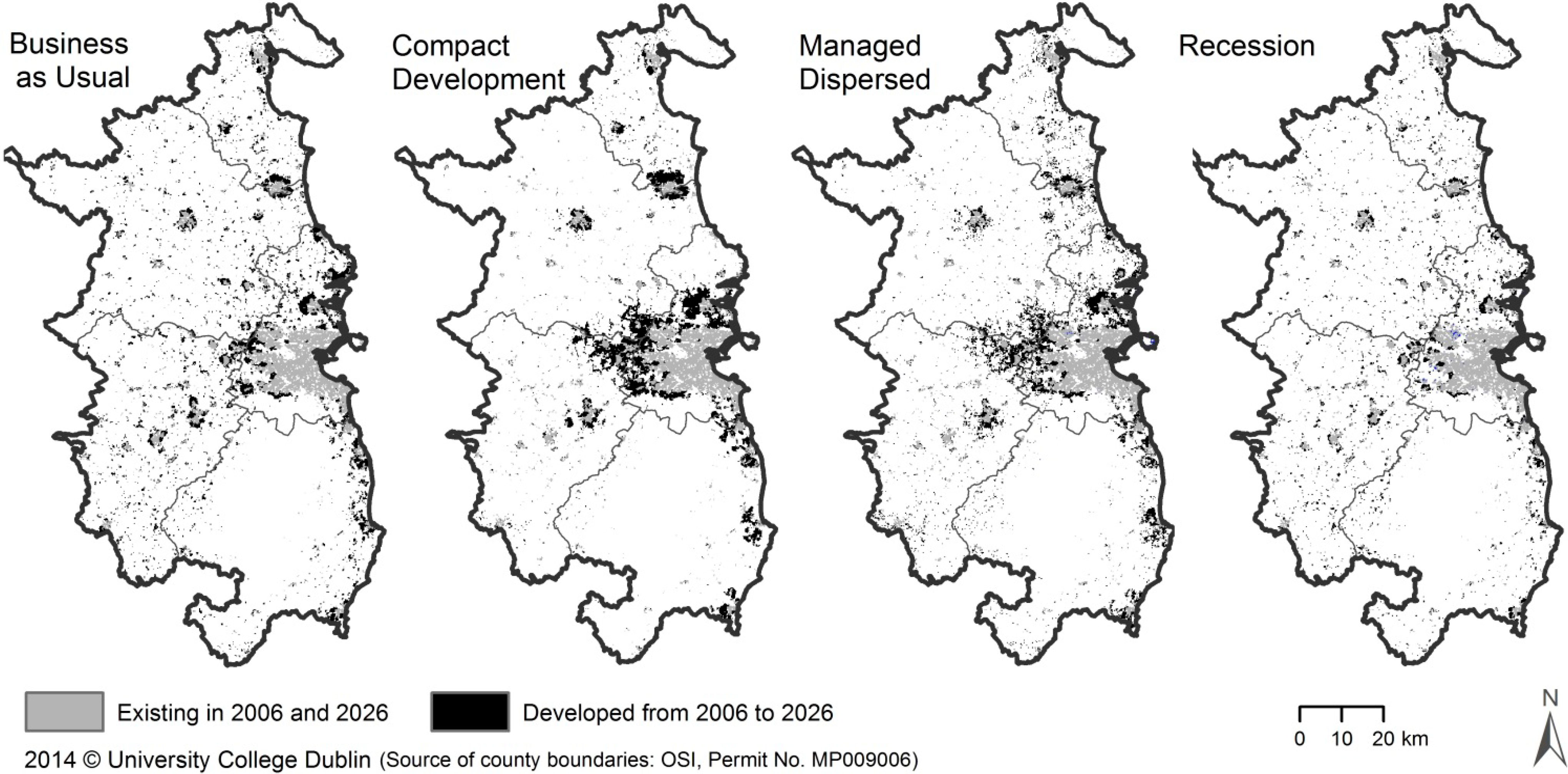
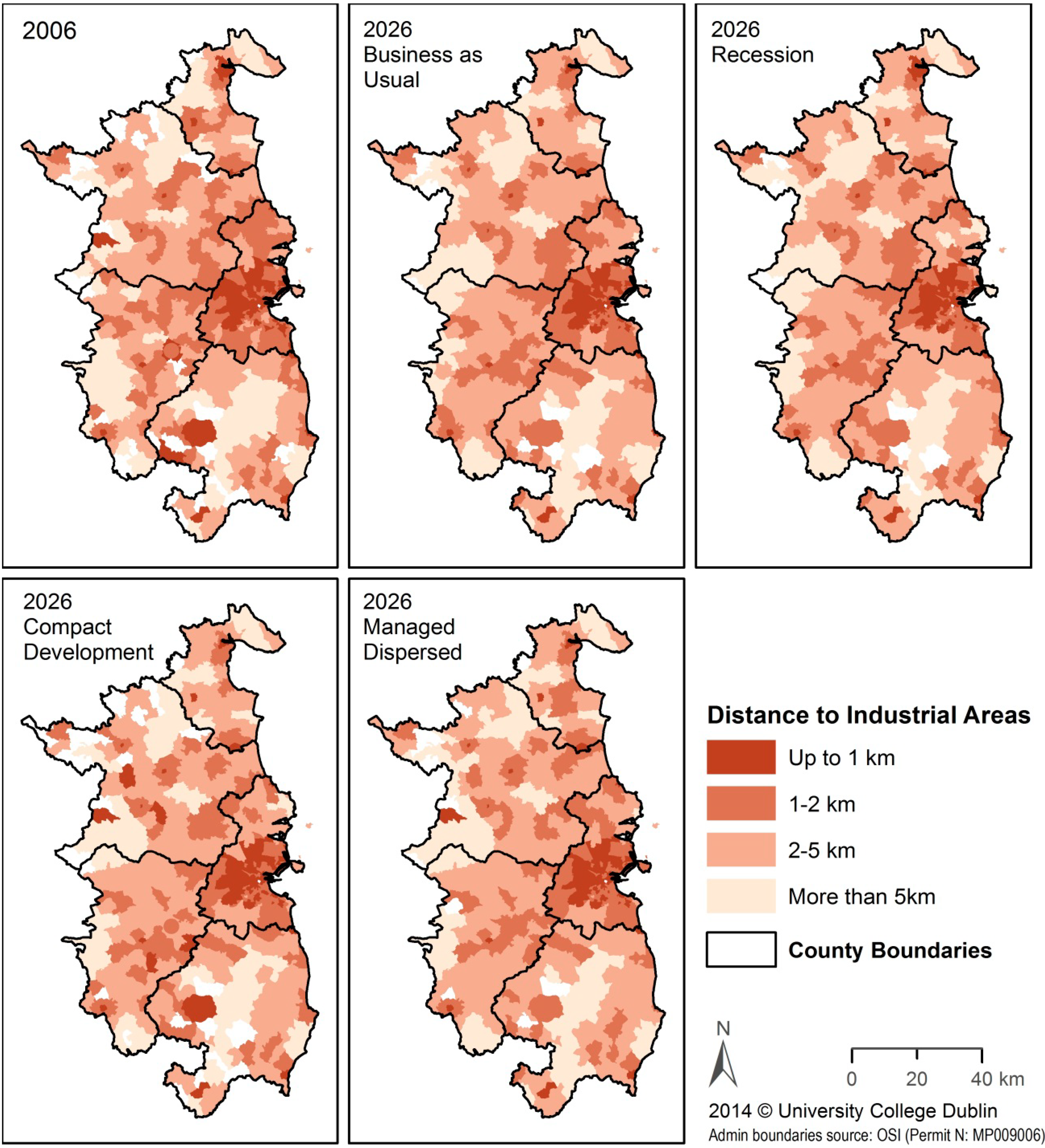
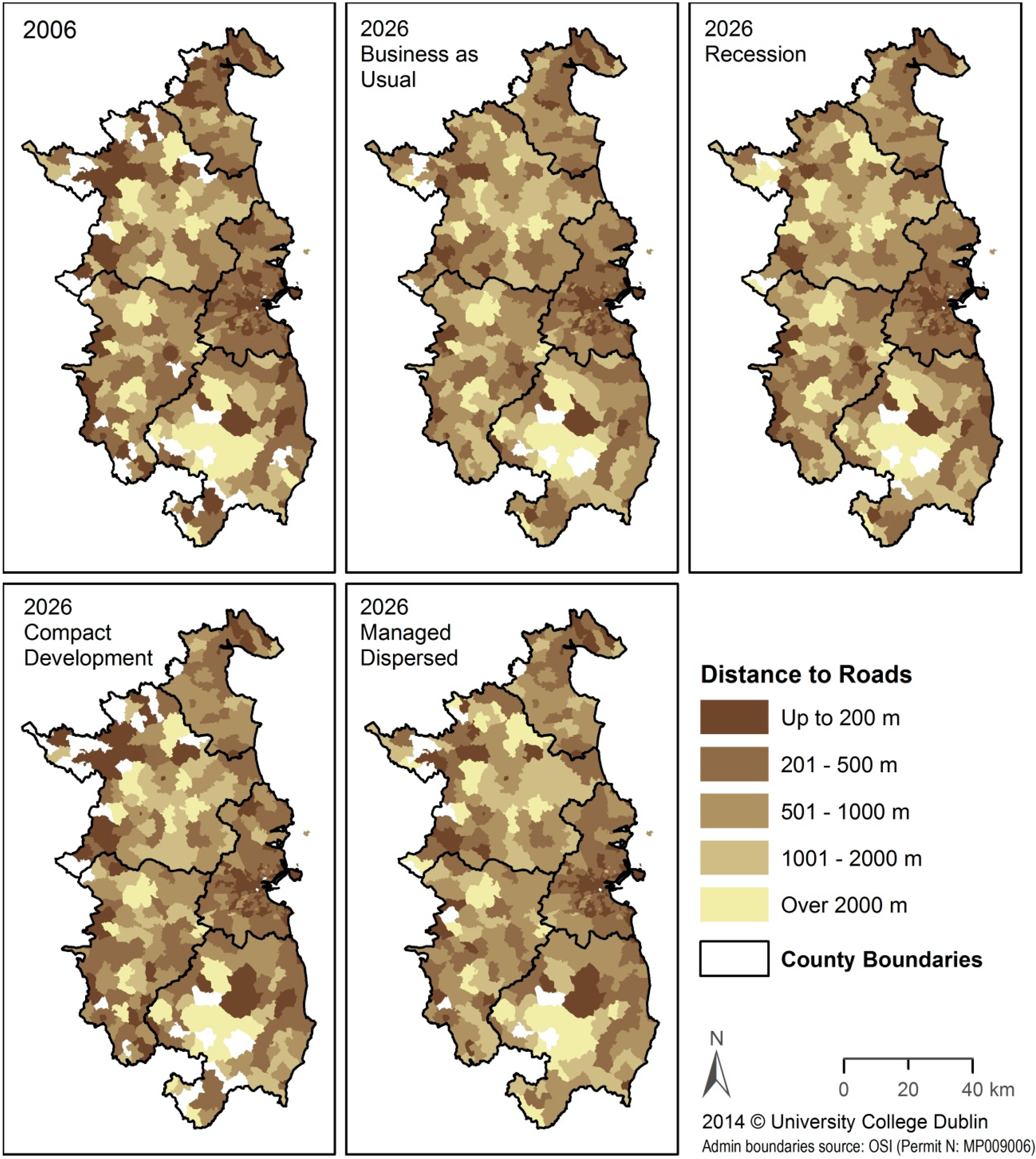
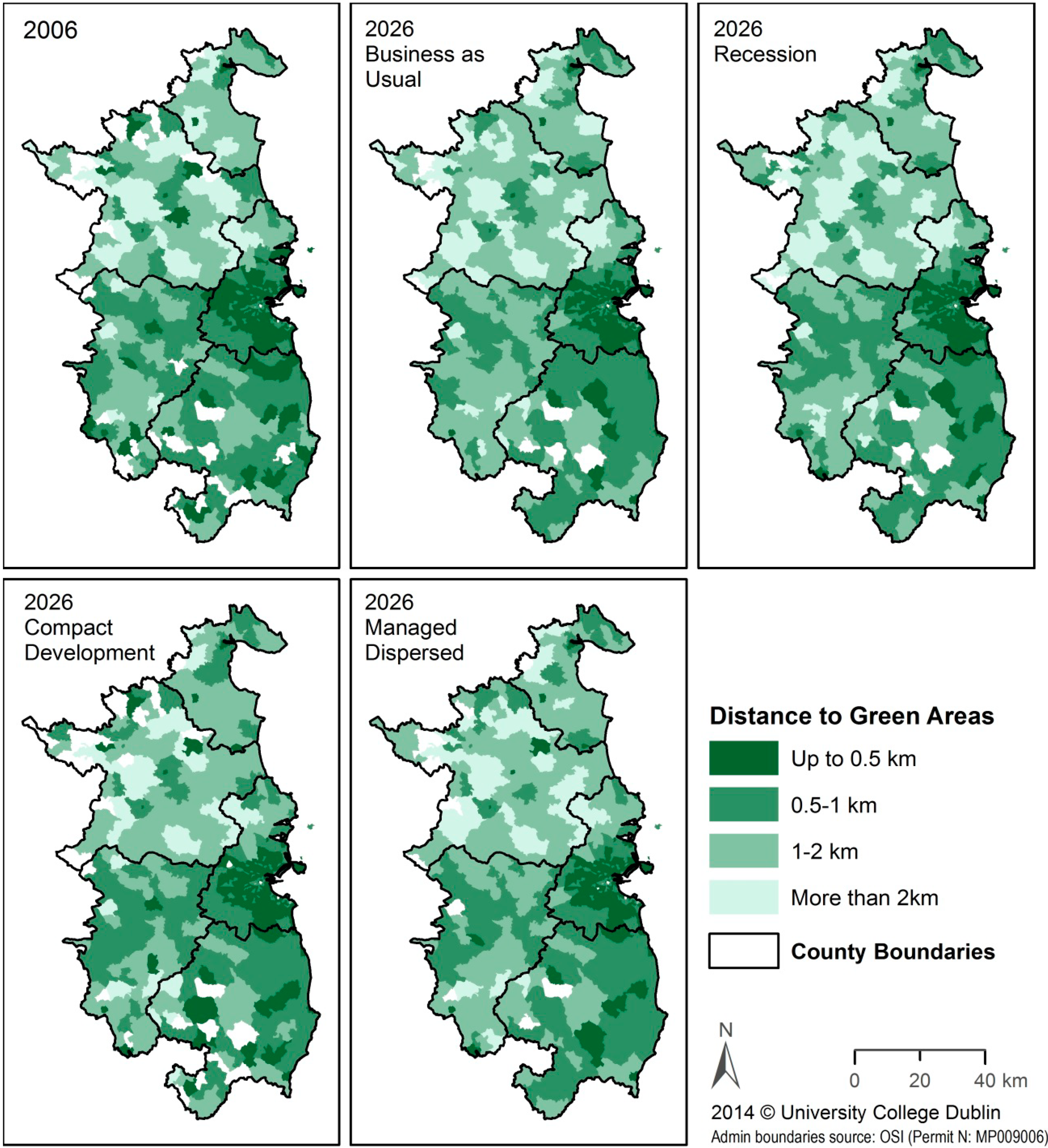
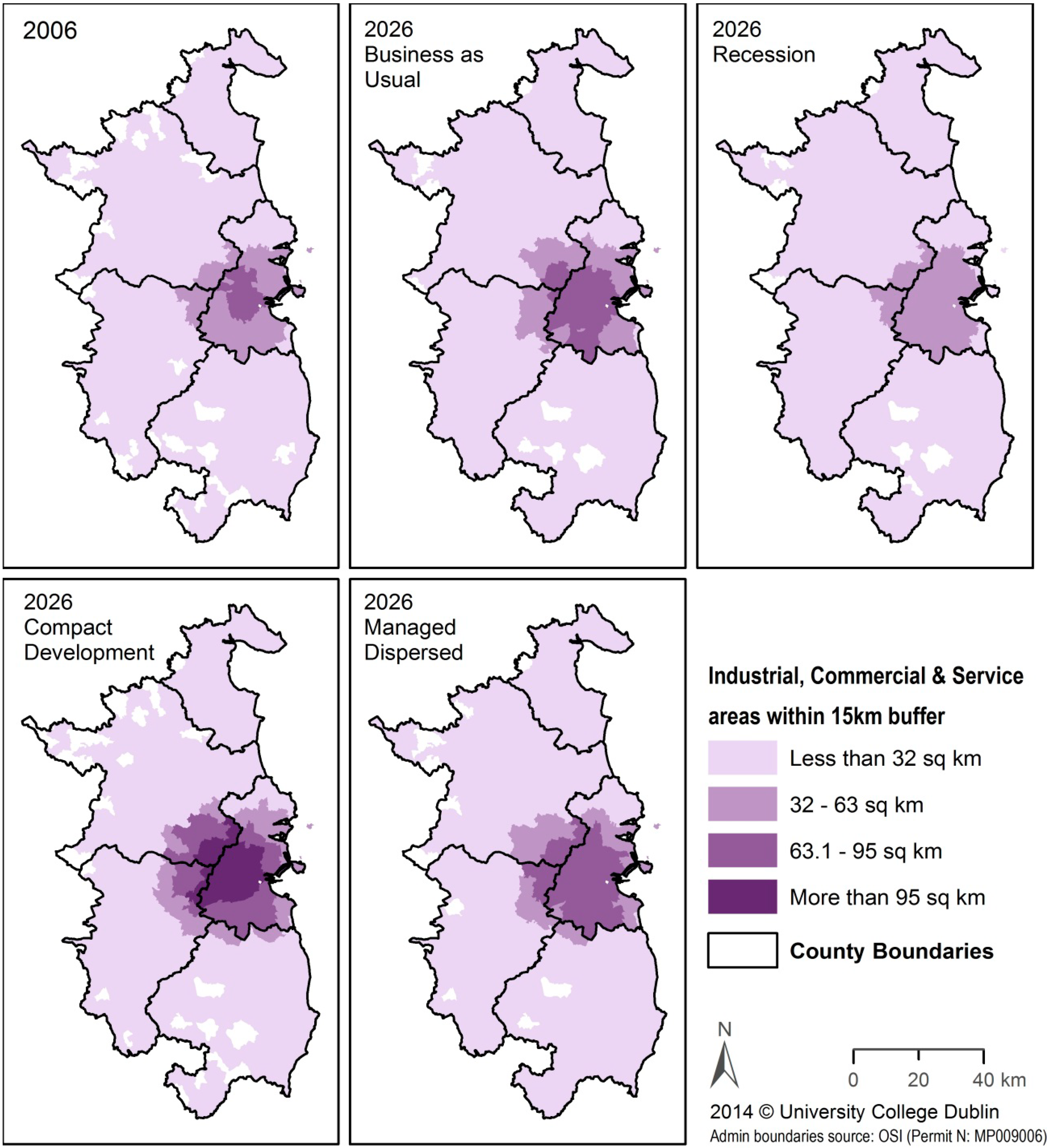
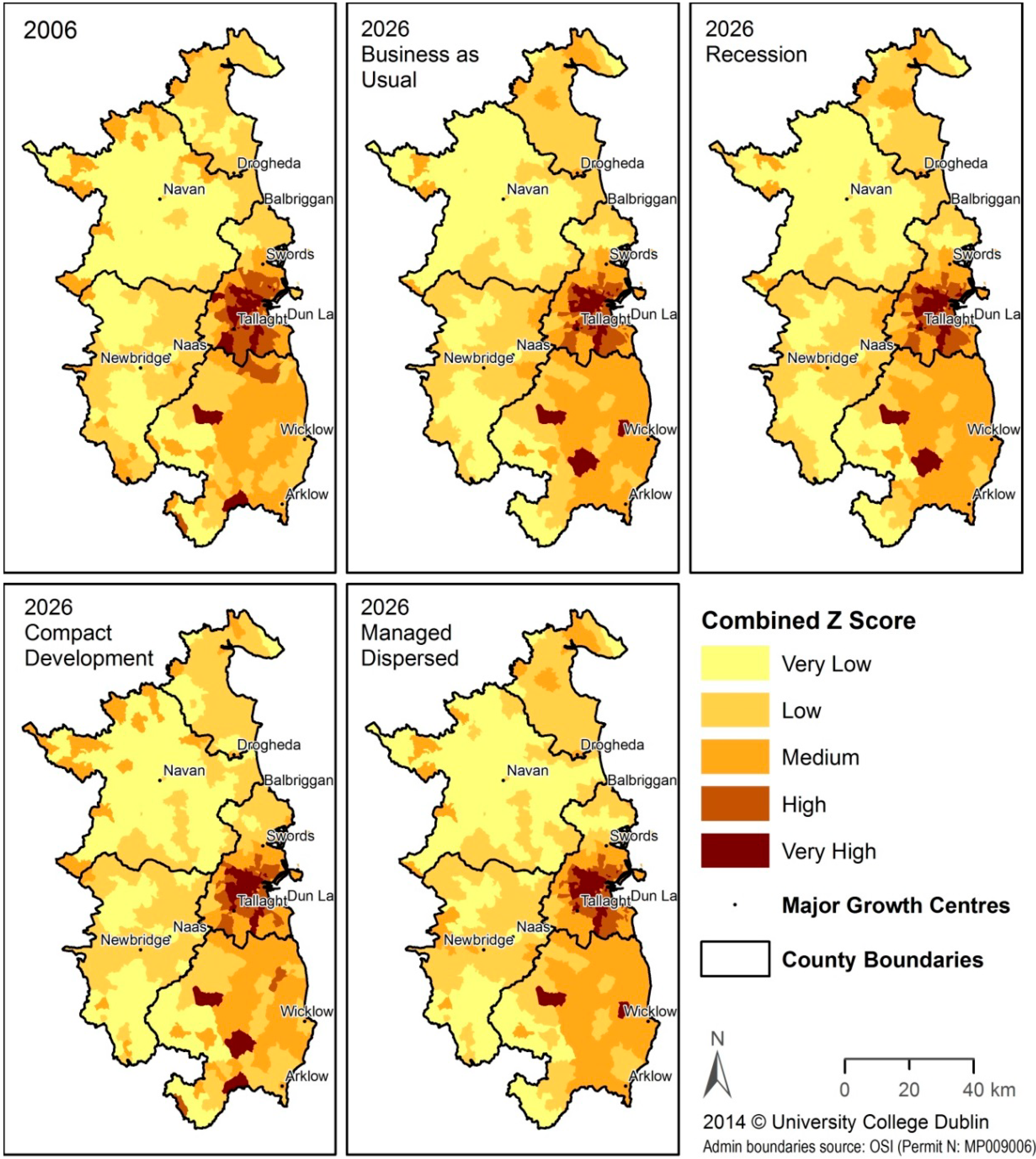
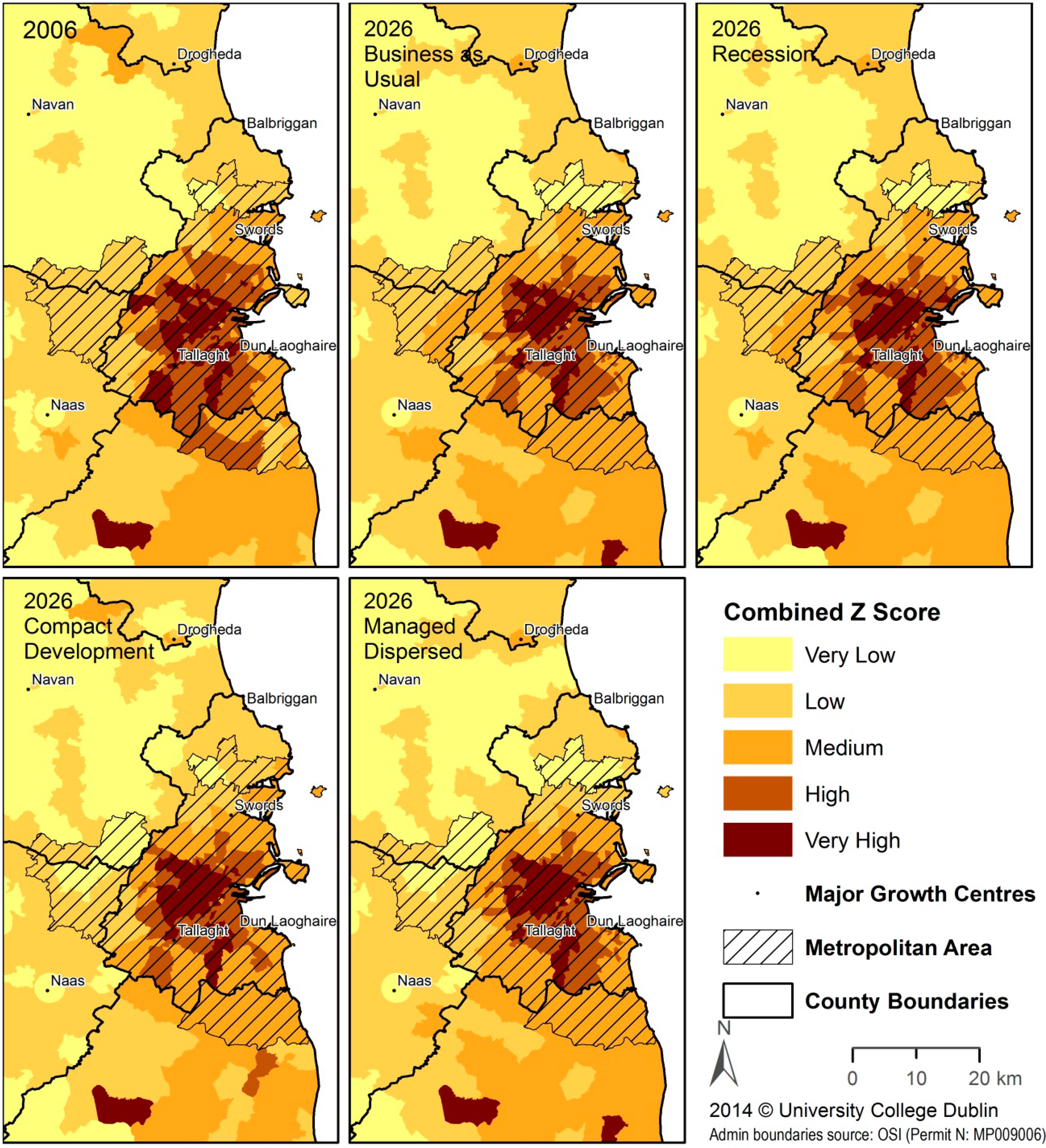
4. Conclusions
Acknowledgments
Author Contributions
Conflicts of Interest
References
- Geertman, S.; Stillwell, J.C.H. Planning Support Systems Best Practice and New Methods; GeoJournal Library, Vol. 95; Springer: Dordrecht, Germany, 2009; Volume XXII, p. 490. [Google Scholar]
- Batty, M. PSS: Progress, Predictions & Speculations on the Shape of Things to Come; UCL CASA Working Paper 122; The Centre for Advanced Spatial Analysis (CASA), University College London: London, UK, 2007. [Google Scholar]
- Shearer, A.W. Approaching scenario-based studies: Three perceptions about the future and considerations for landscape planning. Environ. Plan. B 2005, 32, 67–87. [Google Scholar] [CrossRef]
- White, R.; Straatman, G.; Engelen, G. Planning visualization and assessment: A cellular automata based integrated spatial decision support system. In Spatially Integrated Social Science; Janelle, G., Ed.; Oxford University Press: Oxford, UK, 2004; pp. 420–442. [Google Scholar]
- Williams, B.; Oley, W.; Cudden, J.; Shahumyan, H. Synthesis report: Dublin Ireland’s flagship. In Dublin’s Role in the Irish & Global Economy Project Report; University College Dublin: Dublin, Ireland, 2012. [Google Scholar]
- Mahon, A.J. The Final Report of the Tribunal of Inquiry into Certain Planning Matters and Payments; Planning Tribunal: Dublin Castle, Ireland, 2012. [Google Scholar]
- MyPlan.ie Website. Available online: http://www.myplan.ie/en/newinitiatives.html (accessed on 11 September 2014).
- DoECLG. Putting People First: Action Plan. for Effective Local Government; Department of Environment, Community and Local Government Dublin: Dublin, Ireland, 2012. [Google Scholar]
- Barredo, J.I.; Demicheli, L.; Lavalle, C.; Kasanko, M.; McCormick, N. Modelling future urban scenarios in developing countries: An application case study in Lagos, Nigeria. Environ. Plan. B 2004, 31, 65–84. [Google Scholar] [CrossRef]
- Petrov, L.O.; Lavalle, C.; Kasanko, M. Urban land use scenarios for a tourist region in Europe: Applying the MOLAND model to Algarve, Portugal. Landsc. Urban Plan. 2009, 92, 10–23. [Google Scholar] [CrossRef]
- Shahumyan, H.; White, R.; Petrov, L.; Williams, B.; Convery, S.; Michael, B. Urban development scenarios and probability mapping for Greater Dublin Region: The MOLAND model applications. Lect. Notes Comput. Sci. 2011, 6782, 119–134. [Google Scholar]
- Petrov, L.; Harutyun, S.; Brendan, W.; Sheila, C. Scenarios and indicators supporting urban regional planning. Procedia—Soc. Behav. Sci. 2011, 21, 243–252. [Google Scholar]
- Rametsteiner, E.; Pülzl, H.; Alkan-Olsson, J.; Frederiksen, P. Sustainability indicator development—Science or political negotiation? Ecol. Indicat. 2011, 11, 61–70. [Google Scholar] [CrossRef]
- Haase, T.; Pratschke, J. Deprivation and Its Spatial Articulation in the Republic of Ireland: New Measures of Deprivation Based on the Census of Population, 1991, 1996 and 2002; Area Development Management: Dublin, Ireland, 2005. [Google Scholar]
- Reece, J.; Gambhir, S.; Ratchford, C.; Martin, M.; Olinger, J. The Geography of Opportunity: Mapping to Promote Equitable Community Development and Fair Housing in King County, WA; Kirwan Institute for the Study of Race and Ethnicity, Ohio State University: Columbus, OH, USA, 2010. Available online: http://kirwaninstitute.osu.edu/docs/KingCounty.pdf (accessed on 11 September 2014).
- Reece, J.; Gambhir, S.; Olinger, J.; Martin, M.; Harris, M. People, Place and Opportunity: Mapping Communities of Opportunity in Connecticut; A Report Commissioned by Connecticut Fair Housing Center. Kirwan Institute for the Study of Race And Ethnicity, Ohio State University: Columbus, OH, USA, 2009. Available from: http://www.kirwaninstitute.osu.edu/reports/2009/11_2009_CTOppMapping_FullReport.pdf (accessed on 11 September 2014).
- Batty, M. Urban modelling. In International Encyclopedia of Human Geography; Kitchin, R., Thrift, N., Eds.; Elsevier: New York, NY USA, 2009; pp. 51–58. [Google Scholar]
- Dublin & Mid-East Regional Authorities, The Regional Planning Guidelines Office. Regional Planning Guidelines for the Greater Dublin Area. 2010. Available online: http://rpg.ie/index.html (accessed on 11 September 2014).
- Couch, C.; Leontidou, L.; Petschel-Held, G. (Eds.) Urban Sprawl in Europe: Landscapes, Land-Use Change & Policy; Blackwell: Oxford, UK/Malden, MA, USA, 2007; Volume XIX, p. 273.
- National Spatial Strategy. National Spatial Strategy for Ireland 2002–2020: People, Places and Potential; Stationery Office: Dublin, Ireland, 2002; p. 160. [Google Scholar]
- Housing Agency & Future Analytics. Housing Supply Requirements in Ireland’s Urban Settlements 2014–2018; Housing Agency: Dublin, Ireland, 2014. [Google Scholar]
- Williams, B.; Shahumyan, H.; Boyle, I.; Convery, S.; White, R. Utilizing an urban-regional model (MOLAND) for testing the planning and provision of wastewater treatment capacity in the Dublin Region 2006–2026. Plan. Prac. Res. 2012, 27, 227–248. [Google Scholar] [CrossRef]
- De Almeida, C.; Batty, M.; Monteiro, A.M.; Soares-Filho, B.S.; Cerqueira, G.C.; Pennachin, C.P. Stochastic cellular automata modeling of urban land use dynamics: Empirical development and estimation. Comput. Environ. Urban Syst. 2003, 27, 481–509. [Google Scholar] [CrossRef]
- Dietzel, C.; Clarke, K.C. Replication of spatio-temporal land use patterns at three levels of aggregation by an urban cellular automata. Cell. Autom. Proc. 2004, 3305, 523–532. [Google Scholar]
- Tobler, W.R. Cellular geography. In Philosophy in Geography; Gale, S., Olsson, G., Eds.; Reidel: Dordrecht, The Netherlands, 1979; pp. 379–386. [Google Scholar]
- Batty, M. Cellular automata and urban form: A primer. J. Am. Plan. Assoc. 1997, 63, 266–274. [Google Scholar] [CrossRef]
- Couclelis, H. From cellular automata to urban models: New principles for model development and implementation. Environ. Plan. B 1997, 24, 165–174. [Google Scholar] [CrossRef]
- Yeh, A.G.O.; Li, X. Simulation of development alternatives using neural networks, cellular automata, and GIS for urban planning. Photogramm. Eng. Remote Sens. 2003, 69, 1043–1052. [Google Scholar] [CrossRef]
- White, R.; Engelen, G. Cellular automata as the basis of integrated dynamic regional modelling. Environ. Plan. B 1997, 24, 235–246. [Google Scholar] [CrossRef]
- White, R.; Engelen, G.; Uljee, I. The use of constrained cellular automata for high-resolution modelling of urban land-use dynamics. Environ. Plan. B 1997, 24, 323–343. [Google Scholar] [CrossRef]
- Clarke, K.C.; Gaydos, L.J. Loose-coupling a cellular automaton model and GIS: Long-term urban growth prediction for San Francisco and Washington/Baltimore. Int. J. Geogr. Inf. Sci. 1998, 12, 699–714. [Google Scholar] [CrossRef] [PubMed]
- Silva, E.A. The DNA of our regions: Artificial intelligence in regional planning. Futures 2004, 36, 1077–1094. [Google Scholar] [CrossRef]
- Yeh, A.G.O.; Li, X. A constrained CA model for the simulation and planning of sustainable urban forms by using GIS. Environ. Plan. B 2001, 28, 733–753. [Google Scholar] [CrossRef]
- Barredo, J.I.; Demicheli, L. Urban sustainability in developing countries’ megacities: Modelling and predicting future urban growth in Lagos. Cities 2003, 20, 297–310. [Google Scholar] [CrossRef]
- McCormick, N.; Lavalle, C.; Barredo, J. An example of the application of spatial dynamics modeling for evaluating the future impact of land use development decisions. Proceedings of 4th Seminar of the PlanNet Europe Network on Strategic Environmental Assessment (SEA) of Urban Plans and Programs, Brussels, Belgium; 2005, pp. 47–55. Available: http://planet.difu.de/2005/proceedings/index.phtml (accessed on 11 September 2014).
- Demicheli, L.; Carlo, L.; Marjo, K.; Jose, B.; Niall, M.C.; Valentina, S. Creaton of Territorial and Environmental Data Sets for the County of Harjumaa (Estonia) and the Corridor Tallin-Parnuu; Institute for Environment and Sustainability, EC Joint Research Centre: Ispra, Italy, 2003. [Google Scholar]
- Shahumyan, H.; Twumasi, B.O.; Convery, S.; Foley, R.; Vaughan, E.; Casey, E.; Carty, J.; Walsh, C.; Michael, B. Data Preparation for the MOLAND Model Application for the Greater Dublin Region; UCD Urban Institute Ireland Working Paper Series; University College Dublin: Dublin, UK, 2009. [Google Scholar]
- Shahumyan, H. The MOLAND Model Calibration and Validation for the Greater Dublin Region; UCD Urban Institute Ireland Working Paper Series; University College Dublin: Dublin, Ireland, 2009. [Google Scholar]
- Urban Environment Project Website. Available online: http://www.uep.ie (accessed on 11 September 2014).
- Brennan, M.; Shahumyan, H.; Walsh, C.; Carty, J.; Williams, B.; Convery, S. Regional Planning Guideline Review: Using MOLAND as Part of the Strategic Environmental Assessment Process; UCD Urban Institute Ireland Working Paper Series; University College Dublin: Dublin, Ireland, 2009. [Google Scholar]
- Shahumyan, H.; Convery, S.; Casey, E. Exploring land use-transport interactions in the Greater Dublin Region using the MOLAND model. In Proceedings of the 1st Annual Conference of the Irish Transport Research Network, Dublin, Ireland, 31 August 2010.
- Petrov, L.; Shahumyan, H.; Williams, B.; Convery, S. Applying spatial indicators to support a sustainable urban future. Environ. Prac. 2013, 15, 19–32. [Google Scholar] [CrossRef]
- Engelen, G.; White, R.; Uljee, I. The MOLAND Model for Urban and Regional Growth; Research Institute for Knowledge Systems (RIKS BV): Maastricht, The Netherlands, 2004. [Google Scholar]
- Hurkens, J.; Hahn, B. Using the GEONAMICA® software environment for integrated dynamic spatial modelling. In Proceedings of iEMSs 2008: International Congress on Environmental Modelling and Software, Barcelona, Spain, 7–10 July 2008.
- Donghan, K.; Batty, M. Calibrating Cellular Automata Models for Simulating Urban Growth: Comparative Analysis of SLEUTH and Metronamica; UCL CASA Working Paper 176; The Centre for Advanced Spatial Analysis (CASA), University College London: London, UK, 2011. [Google Scholar]
- Central Statistics Office (CSO). Population and Labour Force Projections 2011–2041; CSO: Dublin, UK, 2008. [Google Scholar]
- Brack, W.; Altenburger, R.; Schüürmann, G.; Krauss, M.; López Herráez, D.; van Gils, J.; Slobodnik, J.; Munthe, J.; Gawlik, B.M.; van Wezel, A.; et al. The SOLUTIONS project: Challenges and responses for present and future emerging pollutants in land and water resources management. Sci. Total Environ. 2014. [Google Scholar] [CrossRef]
- Celino, A.; Concilio, G. Participation in environmental spatial planning: Structuring-scenario to manage knowledge in action. Futures 2010, 42, 733–742. [Google Scholar] [CrossRef]
- Geneletti, D. Environmental assessment of spatial plan policies through land use scenarios: A study in a fast-developing town in rural Mozambique. Environ. Impact Assess. Rev. 2012, 32, 1–10. [Google Scholar] [CrossRef]
- Hewitta, R.; van Delden, H.; Escobar, F. Participatory land use modelling, pathways to an integrated approach. Environ. Model. Softw. 2014, 52, 149–165. [Google Scholar] [CrossRef]
- Engaging the Future—Forecasts, Scenarios, Plans, and Projects; Lincoln Institute of Land Policy: Cambridge, MA, USA, 2007.
- Solecki, W.D.; Oliveri, C. Downscaling climate change scenarios in an urban land use change model. J. Environ. Manag. 2004, 72, 105–115. [Google Scholar] [CrossRef]
- Verburg, P.H.; Veldkamp, A.; Rounsevell, M.D.A. Scenario-based studies of future land use in Europe. Agric. Ecosyst. Environ. 2006, 114, 1–6. [Google Scholar] [CrossRef]
- Xiang, W.N.; Clarke, K.C. The use of scenarios in land-use planning. Environ. Plan. B 2003, 30, 885–909. [Google Scholar] [CrossRef]
- Bergin, A.; Conefrey, T.; Fitzgerald, J.D.; Kearney, I.M. Recovery Scenarios for Ireland; Research Series Number RS007; Economic and Social Research Institute: Dublin, Ireland, 2009; Volume 7. [Google Scholar]
- Central Statistics Office (CSO). Regional Population Projections 2016–2031; CSO Statistical Release: Cork, Ireland, 2013. [Google Scholar]
- Kok, K.; van Delden, H. Combining two approaches of integrated scenario development to combat desertification in the Guadalentin Watershed, Spain. Environ. Plan. B 2009, 36, 49–66. [Google Scholar] [CrossRef]
- De Vor, F.; de Groot, H.L.F. The impact of industrial sites on residential property values: A hedonic pricing analysis for the Netherlands. Reg. Stud. 2009, 45, 609–623. [Google Scholar] [CrossRef]
- Shahumyan, H.; Jankowski, P. Integration of the MOLAND model with GeoChoicePerspectives spatial decision support software for scenario evaluation. In Proceedings of the 13th AGILE International Conference on Geographic Information Science, Guimarães, Portugal, 10–14 May 2010.
- Burton, E. The compact city: Just or just compact? A preliminary analysis. Urban Stud. 2000, 37, 1969–2006. [Google Scholar] [CrossRef]
- Jenks, M.; Burton, E.; Williams, K. (Eds.) The Compact City: A Sustainable Urban Form? Spon Press: London, UK, 1996.
- Haughton, G.; Hunter, C. Sustainable Cities; Jessica Kingsley: London, UK, 1994. [Google Scholar]
- National Spatial Strategy. National Spatial Strategy—The Irish Urban System and Its Dynamics; Government Stationery Office: Dublin, Ireland, 2000. [Google Scholar]
- Quigley, J.M. Urbanization, agglomeration, and economic development. In Urbanisation and Growth; Spence, M., Annez, P.C., Buckley, R.M., Eds.; The International Bank for Reconstruction and Development: Washington, DC, USA, 2009. [Google Scholar]
- Organisation for Economic Cooperation and Development (OECD). Competitive Cities in the Global Economy; OECD: Paris, France, 2007. [Google Scholar]
- Asheim, B.; Cooke, P.; Martin, R. The rise of the cluster concept in regional analysis and policy: A critical assessment. In Clusters and Regional Development: Critical Reflections and Explorations; Asheim, T., Ed.; Routledge: London, UK/New York, NY, USA, 2006; pp. 1–29. [Google Scholar]
- Krugman, P. Innovation and agglomeration: Two parables suggested by city-size distributions. Jpn. World Econ. 1995, 7, 371–390. [Google Scholar] [CrossRef]
- The Center for International Forestry Research (CIFOR). Guidelines for Applying Multi-Criteria Analysis to the Assessment of Criteria and Indicators; CIFOR: Bogor, Indonesia, 1999. [Google Scholar]
- Shahumyan, H.; Williams, B.; Foley, W. Spatial analytic approaches assessing socio-economic development of the Dublin Region: Compared with other regions in Ireland. In Dublin’s Role in the Irish & Global Economy Project Report; University College Dublin: Dublin, Ireland, 2013. [Google Scholar]
Appendix
Indicators Calculation Methodology
A1. Proximity of Residential Areas to Green/Industrial/Commercial/Service Areas
- Land use raster map is converted to a vector map (ArcToolbox > Conversion Tools > From Raster > Raster to Polygon).
- Resulting land use vector layer is intersected with EDs vector layer (ArcToolbox > Analysis Tools > Overlay > Intersect).

- Centroids of all intersected polygons are generated (ArcToolbox > Data Management Tools > Features > Feature to Point).
- Two groups of centroids were selected and exported to new layers: centroids corresponding to residential land use polygons and centroids corresponding to the second relevant land use (green, industrial, commercial, etc.) (ArcToolbox > Analysis Tools > Extract > Select followed by ArcToolbox > Data Management Tools > Features > Copy Features).
- Centroids corresponding to residential land use polygons were spatially joined with ED polygons in which they are located (ArcToolbox > Analysis Tools > Overlay > Spatial Join, using COMPLETELY_WITHIN match option). As a result each “residential” centroid has got corresponding ED code in its attribute table, which will be later used in Summary Statistics.
- The distances between points in the two centroid layers are calculated (ArcToolbox > Analysis Tools > Proximity > Point Distance). This calculates the distances between all possible pairs of points from these two layers.
- Minimum distance from a residential point to the second land use point is identified (ArcToolbox > Analysis Tools > Statistics > Summary Statistics).
- Resulting table is joined with ED layer (ArcToolbox > Data Management Tools > Joins > Add Join).
- Mean minimum distance is calculated for each ED (ArcToolbox > Analysis Tools > Statistics > Summary Statistics).
A2. Proximity to Main Roads/Railway/Coast
- Land use raster map is converted to a vector map (ArcToolbox > Conversion Tools > From Raster > Raster to Polygon).
- Resulting land use vector layer is intersected with EDs vector layer (ArcToolbox > Analysis Tools > Overlay > Intersect).
- Centroids of all intersected polygons are generated (ArcToolbox > Data Management Tools > Features > Feature to Point).
- Centroids corresponding to residential land use polygons are selected and exported to new layer (ArcToolbox > Analysis Tools > Extract > Select followed by ArcToolbox > Data Management Tools > Features > Copy Features).
- “Residential” centroids are spatially joined with ED polygons in which they are located (ArcToolbox > Analysis Tools > Overlay > Spatial Join, using COMPLETELY_WITHIN match option). As a result each “residential” centroid has got corresponding ED code in its attribute table, which will be later used in Summary Statistics.

- The distances from centroids to the nearest object in the “Near” layer (e.g., roads or coastline) are calculated (ArcToolbox > Analysis Tools > Proximity > Near).
- Mean minimum distance is calculated for each ED (ArcToolbox > Analysis Tools > Statistics > Summary Statistics).
A3. Proportion of Residential Areas Adjacent to Major Transport Routes
- A specific (200 m) buffer from major roads is created (ArcToolbox > Analysis Tools > Proximity > Buffer).
- The road buffer is intersected with ED boundaries (ArcToolbox > Analysis Tools > Overlay > Intersect).
- Land use areas are calculated using road buffer and ED intersect polygons as zone feature (ArcToolbox > Spatial Analyst Tools > Zonal > Tabulate Area).
- New field “Residential” is added to the statistics table (ArcToolbox > Data Management Tools > Fields > Add Field).
- The values of Residential field is calculated as a summary of four residential land use types used in the MOLAND land use dataset (ArcToolbox > Data Management Tools > Fields > Calculate Field).
- All other fields in the summary table are deleted.
A4. Quantity of Potential Employers
- Land use raster map is converted to a vector map (ArcToolbox > Conversion Tools > From Raster > Raster to Polygon).
- Resulting land use vector layer is intersected with EDs vector layer (ArcToolbox > Analysis Tools > Overlay > Intersect).
- Centroids of all intersected polygons are generated (ArcToolbox > Data Management Tools > Features > Feature to Point).
- Centroids corresponding to residential land use polygons are selected and exported to new layer (ArcToolbox > Analysis Tools > Extract > Select followed by ArcToolbox > Data Management Tools > Features > Copy Features).
- A buffer with specified distance has created for residential polygon centroids.
- The buffers are dissolved using ED codes.
- Land use areas are calculated using dissolved buffer layer as zone feature (ArcToolbox > Spatial Analyst Tools > Zonal > Tabulate Area).
- Selected land use (industrial, commerce and service) areas are summed.
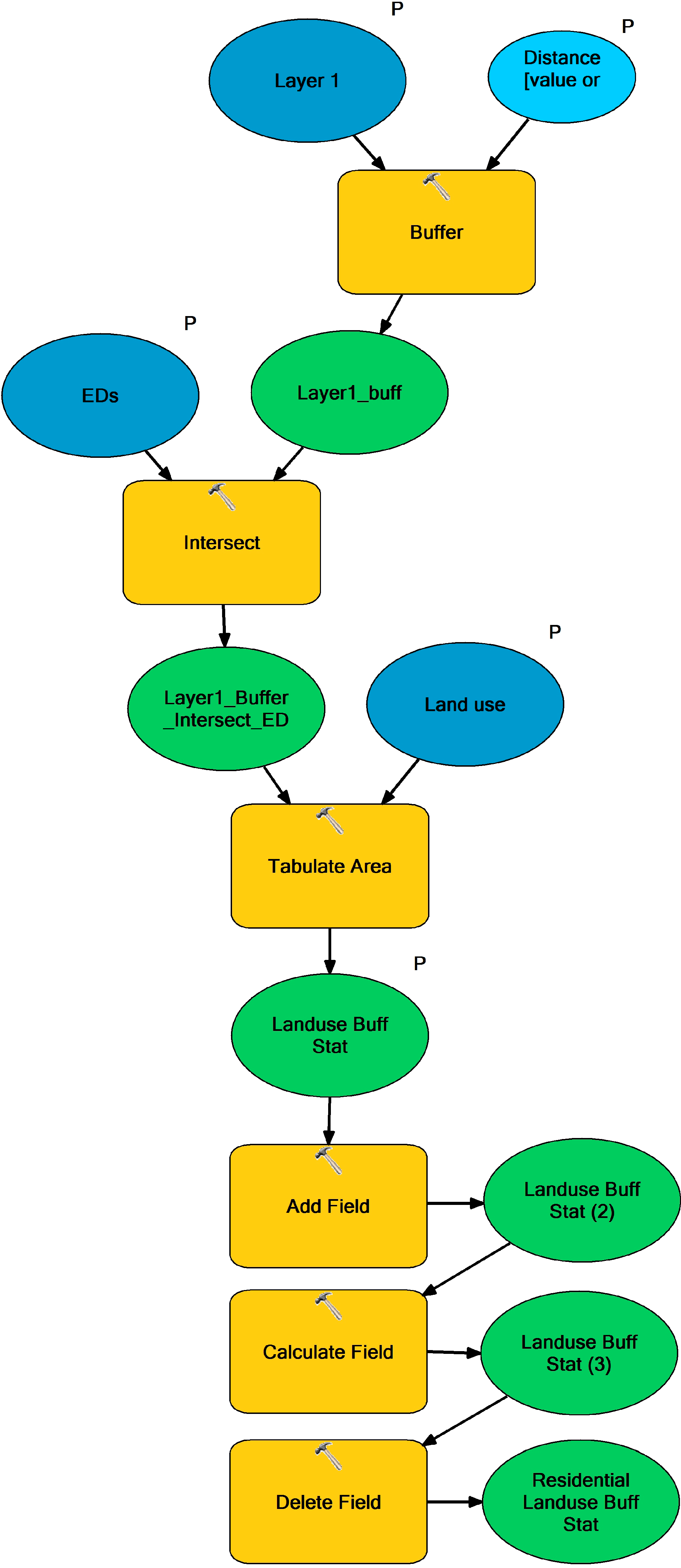
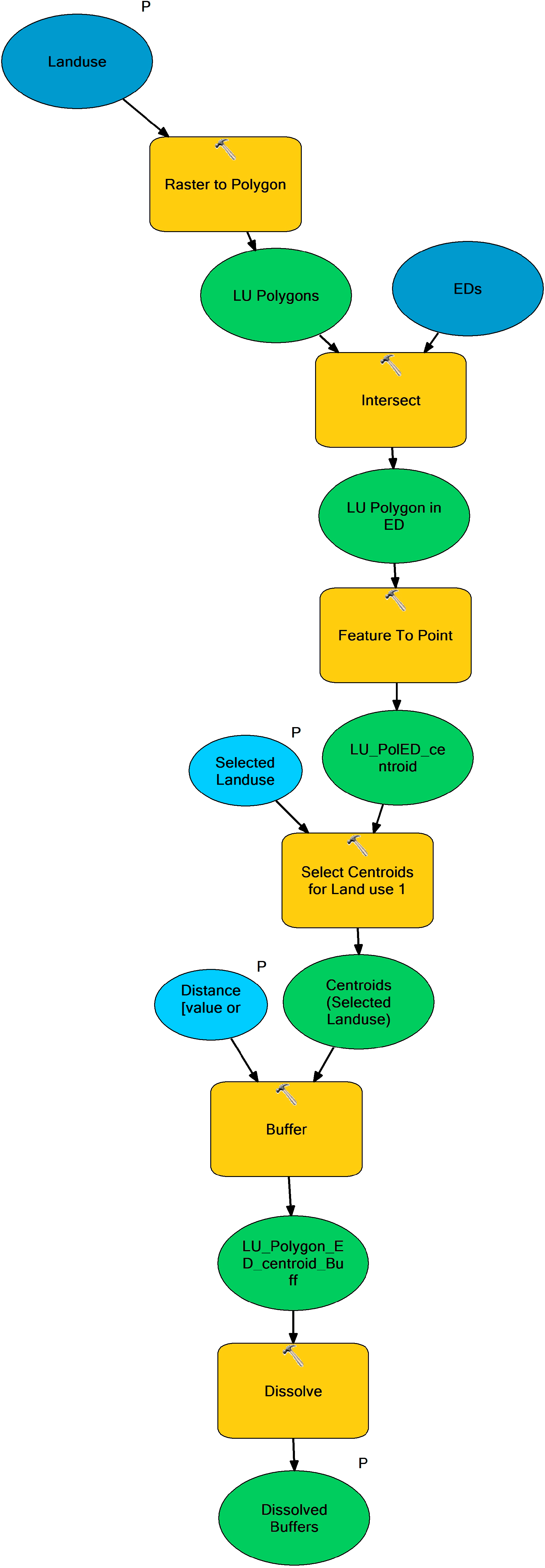
A5. Quantity of Nearby Tertiary Education Institutes
- 1–6
- steps from A4 model;
- 7.
- The dissolved buffers are spatially joined with tertiary institutes layer (as a result the number of the institutes in each buffer for each ED is counted).
A6. Quantity of Nearby Green Areas
- 1–7
- steps from A4 model using 5 km in step 5.
- 8.
- Semi-natural, forest and artificially vegetated areas are summed.
A7. Ratio of Green Areas to Built Areas
- Land use areas are calculated using ED polygons as zone feature (ArcToolbox > Spatial Analyst Tools > Zonal > Tabulate Area)
- The sum of green (semi-natural, forest and artificially vegetated areas) and built areas (residential, industrial, commercial, service) have been calculated for each ED.
- The ratio of the above mentioned sums is calculated.
© 2014 by the authors; licensee MDPI, Basel, Switzerland. This article is an open access article distributed under the terms and conditions of the Creative Commons Attribution license (http://creativecommons.org/licenses/by/3.0/).
Share and Cite
Shahumyan, H.; Williams, B.; Petrov, L.; Foley, W. Regional Development Scenario Evaluation through Land Use Modelling and Opportunity Mapping. Land 2014, 3, 1180-1213. https://doi.org/10.3390/land3031180
Shahumyan H, Williams B, Petrov L, Foley W. Regional Development Scenario Evaluation through Land Use Modelling and Opportunity Mapping. Land. 2014; 3(3):1180-1213. https://doi.org/10.3390/land3031180
Chicago/Turabian StyleShahumyan, Harutyun, Brendan Williams, Laura Petrov, and Walter Foley. 2014. "Regional Development Scenario Evaluation through Land Use Modelling and Opportunity Mapping" Land 3, no. 3: 1180-1213. https://doi.org/10.3390/land3031180
APA StyleShahumyan, H., Williams, B., Petrov, L., & Foley, W. (2014). Regional Development Scenario Evaluation through Land Use Modelling and Opportunity Mapping. Land, 3(3), 1180-1213. https://doi.org/10.3390/land3031180





